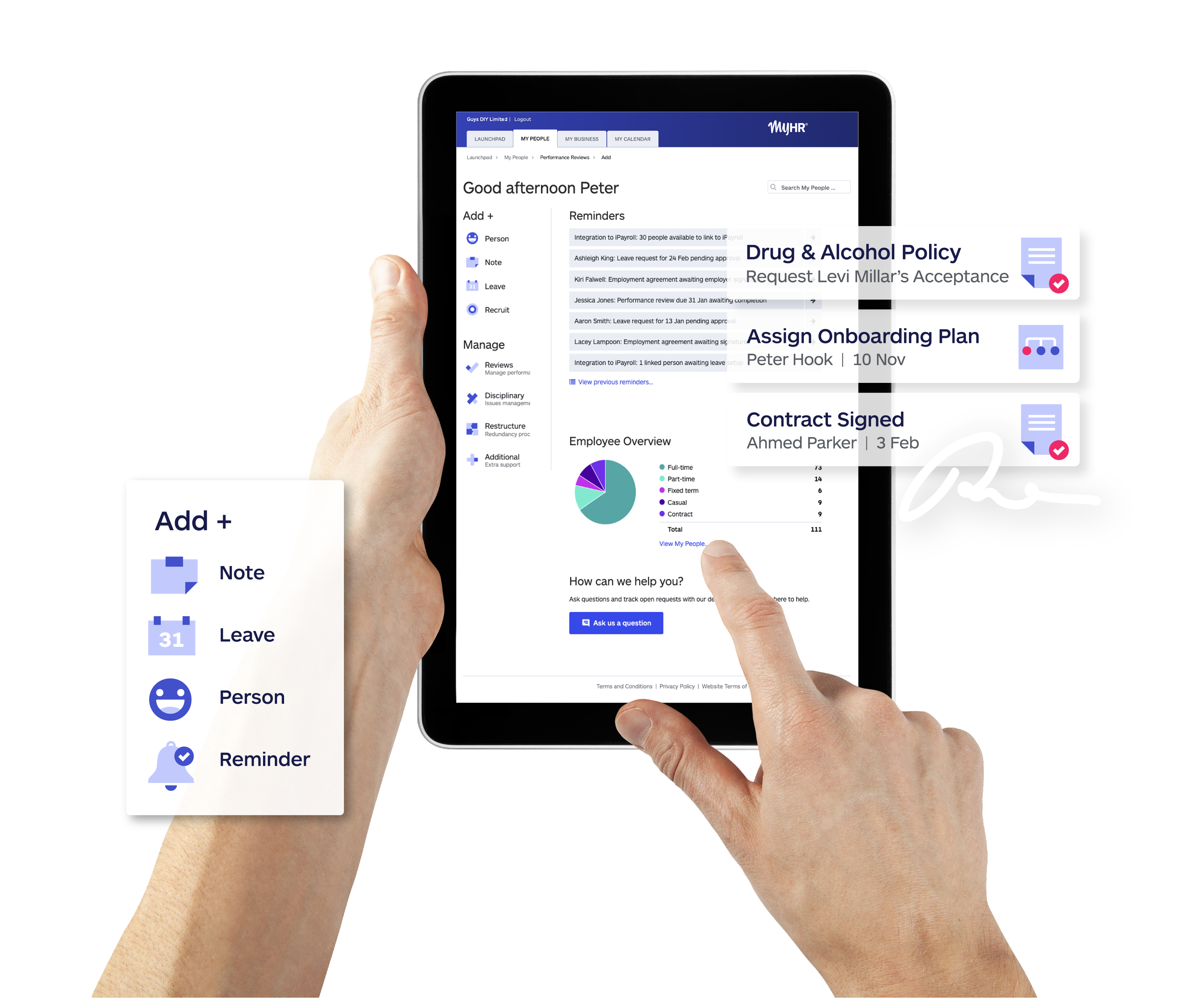There’s been a bit of discussion in some circles about what job descriptions should and shouldn’t cover.
We’ve had people ask why MyHR keeps job descriptions (or position descriptions, as some call them) very succinct, focused on the high-level details and requirements of the job and leaving out any nonessential detail about performance targets or the organisation and its hierarchy.
So, I thought I would spell out the rationale for keeping job descriptions short, sharp, and clear.
First up: what is a job description?
Under NZ law, a job description is 1 of 10 things every individual employment agreement must contain. The Employment Relations Act 2000 states the employment agreement must include ”a description of the work to be performed by the employee.”
So, the content of the job description is a fixed part of the contractual relationship between an employer and employee, agreed to by both parties, written down, and agreed to and stored in the employment agreement. Its primary purpose is to record what the employee is responsible for.
While job descriptions will sometimes include other information, like key stakeholders or a description of the skills and experience required to do the job, fundamentally, the purpose of a job description is to describe the job, rather than the person doing it.
Job descriptions should be flexible
Now, all would be well and good if the nature of the job never changed. But in practice, most roles are dynamic, changing as the business develops, new technology is introduced, or new projects come online.
Most people don’t refer to their job description much once the employment agreement is signed, and most of the time, job descriptions don’t feature heavily in the day-to-day of people showing up to work, doing their job, and being reasonably flexible about the tasks within the scope of their job.
However, legally, if you make “significant” changes to a role (typically of more than 20%), this has to be done by consultation (or mutual agreement) with the employee, and must be reflected in an updated job description for the employee.
This is where long job descriptions that define the job in painstaking detail can get cumbersome, because they can easily and quickly become out-of-date and no one wants to have to regularly re-write them. Worse still, outdated job descriptions that don't accurately reflect the current reality of the role can pose a legal risk to the employer in two primary ways: performance management, and change management.
Performance management
Now, you’re probably not going to have issues with employees that perform well, pull their weight, and understand the needs of the business. They’ll use their initiative and adapt to changes or new ways of working (or actually lead the business in making them).
Where things can get sticky is when you have outdated or inaccurate job descriptions and you need to address poor employee performance or take disciplinary action.
If there is a dispute and you are using the job description as evidence the employee hasn’t done what’s required of them, if it’s not current, the employee may have an argument to say that, because what you’re asking them to do is not in their (otherwise thorough and meticulously detailed) job description, it’s not part of their role.
Or, change management
Convoluted, inaccurate job descriptions could also land you in trouble when you need to make changes to your business’s structure or adjust an employee’s responsibilities.
The reality of the situation will always overrule the paperwork of a situation - e.g. if an employee’s (outdated) job description says they’re an apprentice, but they’re now a plumber and doing a plumber’s tasks every day, you can fairly treat them like a plumber and not an apprentice - but a litigious employee may choose to fight the process and insist that, actually, their employment agreement says they’re an apprentice so they shouldn’t be taken through a restructure with the other plumbers.
It’s not a winnable argument, but for the price of keeping your employment documents and job descriptions reviewed and up to date each year, it’s an easy problem to avoid.
Job grading: Relevant for my business?
For organisations that operate formal job grading, they may well need long, detailed job descriptions that cover reporting lines, budgets, accountability parameters, org charts etc. This enables the job grading professional to work their magic and give the job a “grade” or level, which then places the role in a benchmarked pay band.
In reality, these complex grading requirements are the exclusive domain of large corporate organisations and government departments. In this blog, my interest is in the pragmatic, "real world" of small and medium-sized businesses, where the 7-page JD that satisfies a job grading requirement is just not necessary.
Salary benchmarking and defining jobs doesn’t need to be complex; the data is out there and companies with clear vision, purpose, and values can easily slot roles into their structure, then determine their level.
If you require assistance with salary benchmarking or defining remuneration, MyHR provides salary benchmarking and consultation assistance to ensure your compensation package is as competitive as possible.
Should I include KPIs in my job descriptions
We strongly recommend that you don't put KPIs (or goals, or objectives) in a job description.
Remember, your job description will form part of your employment agreement between you and your employee. If your key performance indicators are included in the employment agreement, and the KPIs need to change or be updated, then you’ll be updating the formal contract between you each time this happens.
It’s also not a useful place to put them - again, most people barely refer to their agreement or JD once the paperwork is signed, so expecting people to regularly refer to it to stay across their KPIs is impractical.
KPIs have their place in performance reviews, where they can be adjusted each year (or review period) to meet these requirements.
Do I need a person profile section?
We don't recommend having a “person profile” section, either. These typically attempt to describe the ideal person’s characteristics, ambitions, and goals, but such descriptions rarely reflect reality and don't help to clarify a person’s expectations about their job and their work, which is why job descriptions are a requirement in an employment agreement.
Person profiles are also a minefield for discrimination. Describing the “ideal person” to perform a job can lead managers down dangerous paths, given all humans carry biases and preferences that are informed by our life experience. You don’t want to add any potential discrimination risks to your employment practices.
What about skills, experience, education, and qualifications?
On the other hand, having a “skills, experience, education, and qualifications” section can be useful. The title is self-explanatory: it’s a brief description of the skills and experience the company believes will make for a successful person in this role. These should be broken down in a bulleted list.
Skills, experience, education, and qualifications are factors that are not inherent to a person’s gender, ethnicity, sexuality and so on, so are much less likely to be discriminatory.
While it isn’t technically a “description of the work to be performed”, it is a picture of the criteria for a successful hire or promotion, which helps soothe conversations with your employees about their career development, performance management, or across units or departments when you’re managing a large team.
The section also covers any critical qualifications or industry certifications that are vital for certain roles, like being a registered member of their profession, carrying a driver's licence, or maintaining a qualification like first aid or working at heights.
Example job description
As an example of our best-practice in action, a Sales Representative’s job description could be as simple as:
- Sell products and meet sales targets.
- Complete reports.
- Be professional.
- Be safe.
- Be nice to customers and colleagues.
- Communicate well.
- Uphold company values.
- Anything else reasonable we ask of you.
Then their performance review (not job description), would look like:
- Increase revenue by 23% year on year.
- Maintain a gross profit margin of 42% on all sales.
- Complete 50 cold-calls per week.
These KPIs may change next year, without requiring a change to the job description or employment agreement. They can be updated to meet business needs and changing market conditions.
When to create a job description
At MyHR, we recommended writing the job description for a role before you advertise the vacancy. It’s all about getting a clear view of what the business needs by defining the work that needs to be done, and what the ideal candidate would bring to the role (job descriptions are great for forming the basis of your job ads).
Launching a recruitment drive without an accurate job description will mean the hiring process could end up shaping the role, because you won’t clearly understand why you’re recruiting or what you need in a candidate, and you won’t be able to clearly articulate it to potential employees.
A poor job description will also make onboarding harder, as your new hire won’t know exactly what they’ve been hired to do. This means more time and effort on the part of management getting the person up to speed.
Read our post on the importance of effective recruitment.
Making changes to a role? Follow good process
Just a word here about following the proper change process. Significant changes to a role must be justifiable (“they didn’t seem like they were performing“ isn’t a good enough reason) and done by consultation in good faith. Don’t go changing a person’s job description without talking to them about it and getting their agreement. Failing to do so could mean your employee has grounds for a personal grievance claim.
If you are making changes to a role or want more general help with your people processes, get in touch with the MyHR team.




